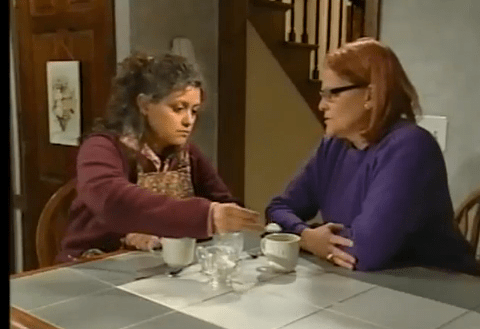Advertisement
Using Soap Operas, Cooking Classes To Fight Diabetes

Eating right and exercising consistently is hard enough with a health club membership and a diet app on your smart phone.
But when you're poor, obese and don't speak English, those goals can be all but unreachable.
So when researchers tried to introduce a healthier diet and lifestyle to a group of adults at risk for developing diabetes in Lawrence, Massachusetts, a primarily low-income city that's 60% Latino, and where only about half the population is fluent in English, they tried to meet people just where they were.
That meant screening a "telenovela," a Spanish soap opera, about a diabetic mom named Martha and her at-risk daughter Sandra, that detailed the fears and challenges of the disease while introducing healthier food choices and busting pervasive misperceptions.
It meant a tour of the supermarket to show participants where the produce and whole grains were located and which aisles had highly processed items to stay away from. It included simple, color-coded food guides with popular items marked in green, yellow and red — like traffic lights — to show which foods should be eaten freely, in moderation or not at all.

And it offered basic cooking classes in Spanish where people were taught to prepared Romaine salads, pinto beans in tomato sauce and boiled sweet potatoes and yams. Many of the classes simply involved modifying recipes, said Dr. Milagros Rosal, Ph.D, associate professor of medicine at the University of Massachusetts Medical School, and a co-author of the study, published in the American Journal of Public Health. "Rather than ask them to eat tofu — which they'd never tried — they were taught to cook rice with less oil, mashed potatoes with less butter and use fat-free chicken broth."
Still, for these study participants, most with less than a high school education and with an average Body Mass Index (BMI) of 35, considered obese, the results were mixed. Over the course of one year, the group that engaged in the various interventions lost, on average, only 2.5 pounds, though their blood sugar levels improved significantly.
"Some might say, 'Two-and-a-half pounds, that's hardly worth the bother,'" said lead study author Ira S. Ockene, MD, professor of medicine, and director of preventive cardiology at the University of Massachusetts Medical School.
But, he said, even that modest weight loss was associated with clinically significant declines in hemoglobin A1C, an important blood-sugar marker that gives a three-month average measure of diabetes control, and significant improvements in insulin resistance. That's progress, he said, for this Latino population with a prevalence rate of diabetes nearly twice that of non-Hispanic whites in the state.
Here are specific numbers from the 312-person study:
Compared with the UC [usual care] group, the IC group [with the interventions] had a modest but significant weight reduction (–2.5 vs 0.63 lb; P=.04) and a clinically meaningful reduction in hemoglobin A1c (–0.10% vs –0.04%; P=.009). Likewise, insulin resistance improved significantly in the IC compared with the UC group. The IC group also had greater reductions in percentage of calories from total and saturated fat.
"A good start" is how Goodarz Danaei, MD, an assistant professor of global health and population at the Harvard School of Public Health put it.
Even with such a culturally tailored approach, where Spanish-speaking members of the Greater Lawrence Family Health Center, the Lawrence Senior Center, the YWCA of Greater Lawrence played a central role, attendance at group sessions was poor: It started off 60% and by the final session had dropped to 20%. And while participants were given pedometers to track their daily step count and encouraged to increase their physical activity, exercise levels did not improve.
Enrique Caballero, MD, an endocrinologist and head of the Joslin Diabetes Center's Latino Diabetes Initiative, said while the community-based approach appeared to be beneficial in boosting certain clinical measures, it clearly wasn't enough to nudge people toward radical changes in exercise habits.
"It's great having people from the community...and tailoring this in a culturally specific way was the right thing to do," said Dr. Caballero, who wasn't involved in the Lawrence study, "but we know from other studies...sometimes there's a need for people with more formal training and background."
[module align="right" width="half" type="pull-quote"]One of the problems in Lawrence is "the more you get into real world situations, the harder things get."[/module]
Researchers agree that the study, officially the Lawrence Latino Diabetes Prevention Project, a four-year, $2.6 million clinical trial funded by the National Institute of Diabetes and Digestive and Kidney Diseases, wasn't long or intense enough to definitively prevent diabetes in this group, almost all of them from the Dominican Republic or Puerto Rico.
Even the folks who showed improvement, "are still considered pre-diabetic, but at less risk," Dr. Ockene said. But, he added, just as previous studies have shown certain populations to be highly sensitive to weight gain, it's possible the same might apply to weight loss. "We think this Hispanic population is one of them."
He makes a distinction here between "medical weight loss" and "cosmetic weight loss."
"Patients come in and they want to lost 40 pounds, and I say, 'You don't need to lose 40 pounds,'" Ockene said. "The message here is 'Hey, you don't have to lose a ton of weight. Even modest weight loss, for certain populations, is beneficial.'"
Back in 2002, results of the Diabetes Prevention Program (DPP), a major study published in The New England Journal of Medicine showed that lifestyle interventions like improved diet and exercise could cut by 58% pre-diabetics' risk of developing the disease.
Dr. David Nathan, director of the diabetes center at Massachusetts General Hospital and the chair of the DPP, said that even though the Lawrence study didn't show the same dramatic benefits, "it's very encouraging. Anything moving in the right direction is a positive thing, and this was an extremely challenging setting."
Ockene said that attempts to duplicate the DPP in populations at highest risk have fallen short. That study, he said, was "intensive and costly" — about $1,399 per participant over the first year — and the people involved were generally well-educated, literate and middle-class. "The best of all possible worlds," Ockene said.
One of the problems in Lawrence, he said, is "the more you get into real world situations, the harder things get."
This program aired on December 16, 2011. The audio for this program is not available.

